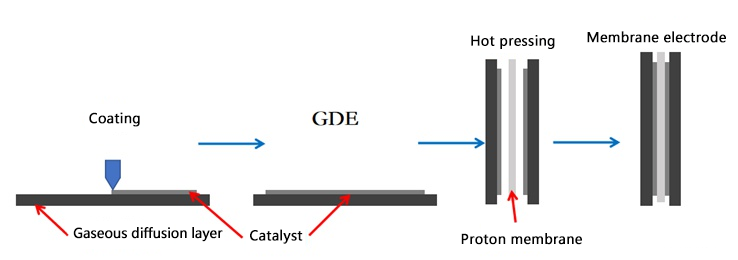- English
- Español
- Português
- русский
- Français
- 日本語
- Deutsch
- tiếng Việt
- Italiano
- Nederlands
- ภาษาไทย
- Polski
- 한국어
- Svenska
- magyar
- Malay
- বাংলা ভাষার
- Dansk
- Suomi
- हिन्दी
- Pilipino
- Türkçe
- Gaeilge
- العربية
- Indonesia
- Norsk
- تمل
- český
- ελληνικά
- український
- Javanese
- فارسی
- தமிழ்
- తెలుగు
- नेपाली
- Burmese
- български
- ລາວ
- Latine
- Қазақша
- Euskal
- Azərbaycan
- Slovenský jazyk
- Македонски
- Lietuvos
- Eesti Keel
- Română
- Slovenski
- मराठी
- Srpski језик
What is GDE?
2023-02-27
GDE is the abbreviation of the gas diffusion electrode, which means the gas diffusion electrode. In the process of manufacturing, the catalyst is coated on the gas diffusion layer as the supporting body, and then GDE is hot pressed on both sides of the proton membrane in the way of hot pressing to form the membrane electrode.
This method is simple and mature, but it has two disadvantages. First, the prepared catalytic layer is thicker, requiring a higher Pt load, and the catalyst utilization rate is low. Second, the contact between the catalytic layer and the proton membrane is not very close, resulting in increased interface resistance, and the overall performance of the membrane electrode is not high. Therefore, the GDE membrane electrode has been basically eliminated.
Working principle:
The so-called gas distribution layer is located in the middle of the electrode. With very little pressure, electrolytes are displaced from this porous system. The small flow resistance ensures that the gas can flow freely inside the electrode. At slightly higher air pressure, the electrolytes in the pore system are confined to the working layer. The surface layer itself has such fine holes that gas cannot flow through the electrodes into the electrolyte, even at peak pressure. This electrode is made by dispersion and subsequent sintering or hot pressing. To produce multilayer electrodes, fine-grained materials are dispersed in a mold and smoothed. Then, other materials are applied in multiple layers and pressure is applied.






